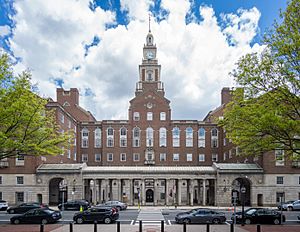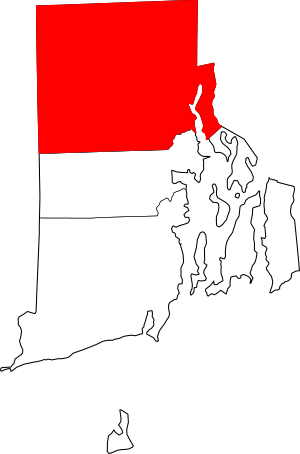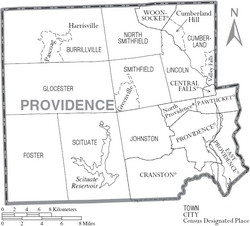Providence County, Rhode Island facts for kids
Quick facts for kids
Providence County
|
|
|---|---|

Providence County Courthouse
|
|

Location within the U.S. state of Rhode Island
|
|
 Rhode Island's location within the U.S. |
|
| Country | |
| State | |
| Founded | June 22, 1703 |
| Named for | Providence, Rhode Island |
| Seat | Providence (1703-1842) |
| Largest city | Providence |
| Area | |
| • Total | 436 sq mi (1,130 km2) |
| • Land | 410 sq mi (1,100 km2) |
| • Water | 26 sq mi (70 km2) 6.0%% |
| Population
(2020)
|
|
| • Total | 660,741 |
| • Density | 1,515.5/sq mi (585.1/km2) |
| Time zone | UTC−5 (Eastern) |
| • Summer (DST) | UTC−4 (EDT) |
| Congressional districts | 1st, 2nd |
Providence County is the most populous county in the U.S. state of Rhode Island. As of the 2020 census, the county's population was 660,741, or 60.2% of the state's population. Providence County contains the city of Providence, the state capital of Rhode Island and the county's (and state's) most populous city, with an estimated 179,335 residents in 2018. Providence County is included in the Providence-Warwick, RI-MA Metropolitan Statistical Area, which in turn constitutes a portion of the greater Boston-Worcester-Providence, MA-RI-NH-CT Combined Statistical Area. In 2010, the center of population of Rhode Island was located in Providence County, in the city of Cranston.
Contents
History
Providence County was constituted on June 22, 1703, as the County of Providence Plantations. It consisted of five towns, namely Providence, Warwick, Westerly, Kingstown, and Greenwich and encompassed territory in present-day Kent and Washington counties. Washington County was split off as King's County in 1729, while Kent County was split off in 1750. The town of Cumberland was acquired from Massachusetts and added to Providence County in 1746-47, and the towns of East Providence and Pawtucket were made part of Providence County when the final border with Massachusetts was settled in 1862. County government in Rhode Island was abolished in 1842. Providence County, like other counties in Rhode Island, has no governmental functions (other than as court administrative and sheriff corrections boundaries which are part of state government).
Geography
According to the U.S. Census Bureau, the county has a total area of 436 square miles (1,130 km2), of which 410 square miles (1,100 km2) is land and 26 square miles (67 km2) (6.0%) is water. It is the largest of Rhode Island's five counties by land area. The county is drained by the Blackstone River, which runs partly along the east border, the Woonasquatucket River in the central part of the county, joining with the smaller Moshassuck River in downtown Providence, and the Pawtuxet, which forms a portion of the southeastern boundary of the county. The Pawtuxet is dammed in the western part of the county to form the Scituate Reservoir, which supplies drinking water for Providence and surrounding communities.
The highest natural point in the county and the state of Rhode Island is Jerimoth Hill at 812 feet (247 m). Sea level is the lowest point.
Adjacent counties
- Norfolk County, Massachusetts - northeast
- Bristol County, Massachusetts - east
- Bristol County - southeast
- Kent County - south
- Windham County, Connecticut - west
- Worcester County, Massachusetts - northwest
National protected area
Demographics
| Historical population | |||
|---|---|---|---|
| Census | Pop. | %± | |
| 1790 | 24,376 | — | |
| 1800 | 25,854 | 6.1% | |
| 1810 | 30,869 | 19.4% | |
| 1820 | 35,736 | 15.8% | |
| 1830 | 47,018 | 31.6% | |
| 1840 | 58,073 | 23.5% | |
| 1850 | 87,526 | 50.7% | |
| 1860 | 107,799 | 23.2% | |
| 1870 | 149,190 | 38.4% | |
| 1880 | 197,874 | 32.6% | |
| 1890 | 255,123 | 28.9% | |
| 1900 | 328,683 | 28.8% | |
| 1910 | 424,353 | 29.1% | |
| 1920 | 475,190 | 12.0% | |
| 1930 | 540,016 | 13.6% | |
| 1940 | 550,298 | 1.9% | |
| 1950 | 574,973 | 4.5% | |
| 1960 | 568,778 | −1.1% | |
| 1970 | 580,261 | 2.0% | |
| 1980 | 571,349 | −1.5% | |
| 1990 | 596,270 | 4.4% | |
| 2000 | 621,602 | 4.2% | |
| 2010 | 626,667 | 0.8% | |
| 2020 | 660,741 | 5.4% | |
| U.S. Decennial Census 1790-1960 1900-1990 1990-2000 2010-2019 |
|||
2010 census
As of the 2010 United States Census, there were 626,667 people, 241,717 households, and 149,691 families living in the county. The population density was 1,530.3 inhabitants per square mile (590.9/km2). There were 264,835 housing units at an average density of 646.7 per square mile (249.7/km2). The racial makeup of the county was 73.4% white, 8.5% black or African American, 3.7% Asian, 0.7% American Indian, 0.1% Pacific islander, 9.6% from other races, and 4.2% from two or more races. Those of Hispanic or Latino origin made up 18.8% of the population. The largest ancestry groups were:
 18.5% Italian
18.5% Italian 15.8% Irish
15.8% Irish 12.3% French
12.3% French 9.4% English
9.4% English 8.6% Portuguese
8.6% Portuguese 5.4% French Canadian
5.4% French Canadian 5.4% Dominican
5.4% Dominican 4.9% Puerto Rican
4.9% Puerto Rican 4.3% Cape Verdean
4.3% Cape Verdean 4.2% German
4.2% German 3.8% Polish
3.8% Polish 2.9% Guatemalan
2.9% Guatemalan 1.7% Scottish
1.7% Scottish 1.6% American
1.6% American 1.2% Swedish
1.2% Swedish 1.2% Colombian
1.2% Colombian 1.1% Mexican
1.1% Mexican 1.0% Scotch-Irish
1.0% Scotch-Irish 1.0% Arab
1.0% Arab
Of the 241,717 households, 31.4% had children under the age of 18 living with them, 40.8% were married couples living together, 15.8% had a female householder with no husband present, 38.1% were non-families, and 30.2% of all households were made up of individuals. The average household size was 2.48 and the average family size was 3.11. The median age was 37.0 years.
The median income for a household in the county was $48,500 and the median income for a family was $61,265. Males had a median income of $44,964 versus $36,447 for females. The per capita income for the county was $25,169. About 11.6% of families and 15.4% of the population were below the poverty line, including 22.1% of those under age 18 and 11.5% of those age 65 or over.
Communities
Cities
- Central Falls
- Cranston
- East Providence
- Pawtucket
- Providence (traditional county seat)
- Woonsocket
Towns
Census-designated places
Other villages
See also
 In Spanish: Condado de Providence para niños
In Spanish: Condado de Providence para niños


